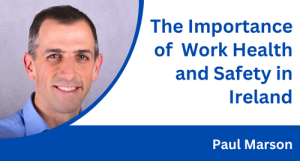
We’re delighted to introduce you to our Health and Safety Consultant, Paul Marson. With over 25 years of experience, Paul has a proven track record and an excellent reputation for supporting businesses to respond to an ever-increasing regulatory environment. He has experience providing Health and Safety solutions to a wide variety of industries including logistics, manufacturing, medical device, finance, semi-state, technology, and childcare.
We sat down with Paul to learn more about his role, his career highlights and ask him his thoughts on the state of Workplace Health and Safety in Ireland.
Why did you start a career in Workplace Health and Safety?
I wanted a career where I felt what I do makes a real difference.
Working in Health and Safety is a highly rewarding profession, engaging with people at all levels to support organisations in the area of health and well-being, to keep their staff, colleagues, friends, and often family safe and well, so they can return home to their loved ones safe and well from work each day.
With a lot of what I do, I know I am saving lives, but if I do my job right, it happens without any of the drama of the blue lights and sirens.
Health and safety professionals are fundamental to modern businesses and play a key part in preventing workplace injuries, ill health, and deaths by managing the day-to-day risks that workers may face. They help organisations stay legally compliant as well as drive business processes and culture to provide a sustainable, healthy, and productive workforce.
What impact did the Covid pandemic have on Health and Safety?
The COVID-19 pandemic had a significant impact on health and safety professionals in Ireland. With the outbreak of the virus, there was an increased awareness of health and safety measures at work as employers and employees alike sought to ensure that their workplaces were safe and compliant with public health guidelines. There were long hours to react and recalculate best practices based on changing governmental guidance but I’m very proud of all the great work that was done to protect businesses across Ireland. The pandemic has definitely led to greater recognition of the value that Health and Safety measures and protocols bring to Irish workplaces.
Can you describe your experience with regulations and compliance?
I have extensive experience in workplace safety regulations and compliance, including conducting internal and external safety audits to ISO 45001 standards, while developing safety programs, and training employees to QQI, PHECC and IOSH standards and have a proven track record of helping organisations to comply with their legal or industry requirements. I also develop programs to go beyond basic compliance, on the road to best practice of best in class, and design work safety programmes that benefit both the employees on the ground and in turn improve business H&S culture as well as H&S and overall performance.
Can you give an example of a successful safety program you have implemented in the past?
One example of a successful safety program I implemented in the past was for a world leader in Logistics. The company had a high rate of accidents, and a high rate of absence due to the nature of the work and the inability to accurately gauge the type of quantity of workload from day to day. I worked with management and employees to develop a comprehensive Risk assessment program, so that we could identify the hazards involved in the process and the risks to the workforce from these hazards.
We then started with an awareness campaign, for all staff, at all levels, outlining the hazard in the process and the risks involved, the plan to remove or reduce the hazards, the part each person would play in the successful removal of these hazards, what removing these hazards would mean to the entire organisation, and its customers.
As part of the removal of the hazards, assigned staff members carried out regular inspections and audits of areas under their control, so that we could measure progress on the improvement projects to remove each hazard, and therefore the risk reduction. This involvement and consultation with all levels of the organisation, meant that everyone was aware that they had a part to play in Health and Safety. Everyone knew the hazards, knew the risks, knew the plan to remove hazards and reduce the risks as well as the reasons why.
As part of the process improvement Health and Safety performance was integrated into everyone’s performance targets. Global targets for risk reduction in the organisation were set as KPIs for all staff in the organisation.
Hazard reduction projects included changing vehicles to shelved units or to better suit manual handling requirements. Changing processes to follow process flow and utilise up-to-date technology such as wireless scanning technology to prevent double handling. Upskilling line managers and staff to take an active part in all accident investigation and prevention, so that there was a solution focus, not a blame culture. The mechanisation of certain hazardous processes around pallet handling from pallet wrap to ride on power pallet trucks, and more dock levelers. Nothing was off the table which meant we changed several premises for more space, better access, better facilities, and more automation of processes.
The results from all of this focus was to achieve a lost time injury frequency rate which was a record low for the organisation and to sustain it for three consecutive years.
As well as that the organisation went two years without a single personal injury claim, from a high of twelve per year for the previous ten years.
How should companies handle workplace safety incidents?
The priority is to ensure the safety and well-being of all employees involved, whether directly, or those carrying out a similar process elsewhere who may be affected, or those who are trying to recover the process following the incident. Everyone needs to know it is a root cause investigation not a blame game.
The important thing is to treat every incident investigation the same and to include appropriate stakeholders in the investigation, it is a process. Each incident needs the same level of attention and scrutiny, as it may be a near miss that you can prevent recurrence of today, but without the correct intervention may lead to a serious or fatal incident tomorrow. From a broken nail to a broken back, they all get the same level of investigation.
Immediately begin an investigation to record and capture the situations which led up to the incident to assist in determining the root cause. Witness statements, statements of others who carry out the same task or use the same equipment, photos of the scene, weather conditions, light levels, samples of any objects involved, CCTV of the incident, maintenance records, and training records all play a part in identifying the correct steps to be taken to prevent an incident like this happening again. Fishbone diagrams, the 5 Whys? Etc can all be utilised to ensure the root cause is identified for the incident.
How an organisation approaches accident investigation can have a huge impact on the Health and Safety culture of that organisation. The more it is seen as an opportunity to improve a process and protect staff members, the more buy-in to H&S the organisation may expect from staff.
How can organisations communicate safety information to employees?
There are a variety of ways to communicate any new safety information to employees, including through regular safety meetings, training and upskilling sessions, toolbox talks, workplace apps, notice boards, coffee station water cooler notices, having Health and Safety as an agenda item at all meetings at all levels.
I encourage open two-way communication and feedback at all levels of an organisation. This gives employees the opportunity to highlight their concerns as well as share ideas for improving safety in the workplace.
However, the best way of communicating general Health and Safety is by seeing it and living it day to day. Everyone can communicate safety information through their actions, and how they go about their work. Doing things, the right way, as per a process and standards of the organisation or industry and not accepting shortcuts or one-offs. While highlighting to those individuals who are not operating to the same standards what the ramifications of their actions could be, and whom their actions may affect (Their colleagues their friends, and their families). When it comes to Health and Safety behaviour breeds behaviour, and it is the best way of communicating without saying a word.
Are there any legislative changes coming down the track that may impact businesses and Workplace Safety in 2023?
Some areas to keep an eye on over the next 12 to 24 months are in the areas of:
- Change in regulations for display screen equipment will be coming in the next year or so, to take account of the new hybrid way of working, as well as the new technology in the workplace.
- Possible changes to a 4-day week and knock-on implications to employers are still being discussed at cabinet level but are on the horizon for 2024.
- How labour shortages in the market are having an impact on employee health and wellbeing as we struggle to make do with less staff and more demands on our time.
As always if you have any questions or concerns about Health and Safety Regulations impact your business please contact our experts in Adare Human Resource Management on 01 561 3594 / 061 363 805 or email info@adarehrm.ie.
